Heroin Rehab Center in West Virginia
Uncover the empowering tools and personalized support designed to help you reclaim your life. Take the initiative and learn how we can assist you in breaking free from the grip of heroin addiction.
At Harmony Ridge Recovery, we have a firm grasp on this longstanding issue. Heroin addiction requires a careful, calculated approach, and each individual comes with their own unique needs as well. Our West Virginia heroin rehab center addresses both, by offering expansive, thorough treatment, while personalizing it for each case. We offer an array of programs, treatment methods, and aftercare support frameworks that make every journey to recovery unique and effective. If you would like to know more before seeking our help, please read on.Across the US, heroin addiction may not be quite as prevalent as addictions to other substances. Opioids, prescription drugs, and cocaine are quite more common as of 2022. However, heroin remains extremely addictive, and in many regards can be far more dangerous than most other substances.
Most of us are aware that the United States is in the midst of a national overdose epidemic. What is the type of substance stealing the limelight of the epidemic? Opioids. Heroin is an opiate drug derived from the seedpods extracted from the poppy flower. Thus, heroin treatment centers have been in demand. A heroin rehab center could be the difference between a sudden overdose within the family and sustainable health.
Nobody starts out being a heroin addict. In fact, many people start having opioid use issues after being prescribed opioid pain medication prescribed by their doctors. This is because when the prescription runs out and the doctor won’t prescribe more refills, the cravings for pleasure and relief begin. At that moment, many of those people desperate to receive that feeling of pleasure and relief again start using the illegal opioid known as heroin. It also doesn’t help that heroin is cheaper and stronger than prescription opioids and easier to get.
If you or a loved one has a substance use disorder, you are probably trying to hide it. It is common to try to avoid the stigma of drug addiction, not to mention the legal ramifications that may come from using illegal substances or abusing any sort of substance at all. Since you are reading this, you probably already suspect that you or someone close to you has a substance use problem. You might have even already made plans to attend a heroin addiction treatment program.
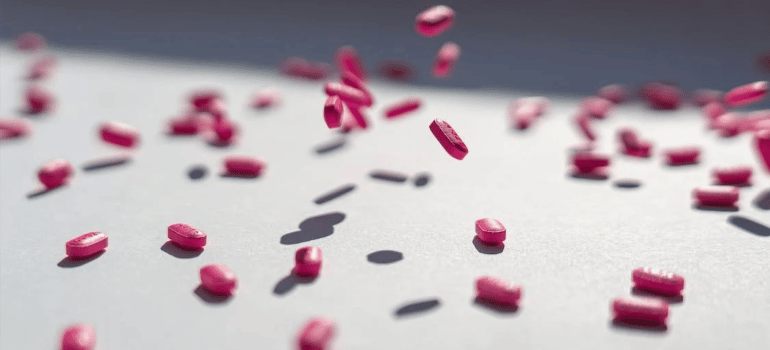
Reasons Not to Detox from Heroin on Your Own
First and foremost, we should strongly advise you to not attempt to detox from heroin on your own. It is a very dangerous process to initiate without medical supervision, and heroin rehab centers across the nation will attest to this.
To many, detoxing by themselves sounds appealing because the withdrawal process doesn’t last long. Indeed, as AC outlines, the withdrawal timeline typically only lasts for a week. This fact does not account for the serious risks involved or the post-detox challenges ahead. To explain, let us break those factors down.

The Dangers of Unsupervised “Cold Turkey” Detox
That is not to say that unsupervised detox is often fatal. WebMD cites Aaron Sternlicht, LMHC, CASAC, who clarifies:
“Contrary to common belief, heroin withdrawal actually has a low fatality rate[.] Although complications can occur from opioid withdrawal, death from heroin and other opioids usually results from an overdose, not withdrawal”.
In itself, this is a true statement. However, withdrawal symptoms can put the individual at serious risk in 3 key ways:
- Physical harm. Symptoms like diarrhea and vomiting can lead to serious dehydration and even death, as the World Health Organization (WHO) finds. Fatigue and muscle spasms can also endanger the individual during everyday activities, such as driving or operating professional equipment.
- Psychological harm. Depression and anxiety can also directly fuel addiction, especially in cases of dual diagnosis. Co-occurring mental health disorders can increase the likelihood of an overdose, which does carry a much higher fatality rate.
- Emotional harm. Finally, failed attempts at detox can discourage the individual from ever seeking treatment. Maintaining an addiction because of this can also “enhance HIV and/or HCV infection risk”, as the National Institute of Health (NIH) finds.
This is why Sternlicht also concludes that:
“[O]pioid withdrawal can be life-threatening, and it is always encouraged for individuals to seek out an addiction specialist and a supervised medical detox when withdrawing from heroin.”
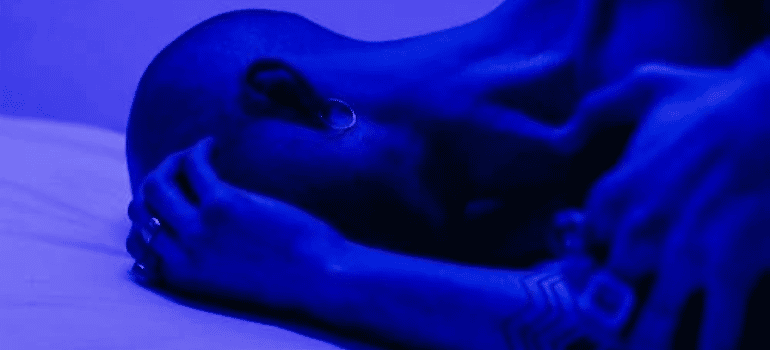
Heroin Withdrawal Symptoms
The primary reason for this lies in withdrawal symptoms themselves. The exact intensity is of course subjective and will vary, but the symptoms are typically severe by nature. The National Institute on Drug Abuse (NIDA) identifies the following withdrawal symptoms:
- Restlessness
- Severe muscle and bone pain
- Sleep problems
- Diarrhea and vomiting
- Cold flashes with goose bumps
- Uncontrollable leg movements
- Severe heroin cravings
To those, AAC adds the following:
- Nausea
- Abdominal pain
- Sweating
- Shaking
- Nervousness
- Agitation
- Depression
Needless to say, the vast majority of such symptoms often disrupt one’s daily life too much to ignore. The cravings alone are powerful enough to foil many attempts, and an initial failure may completely discourage attempts at recovery. Even if you do overcome that challenge, the other symptoms can present very serious risks. Our West Virginia heroin rehab specialists have seen them manifold, which is why we advise against it so strongly.
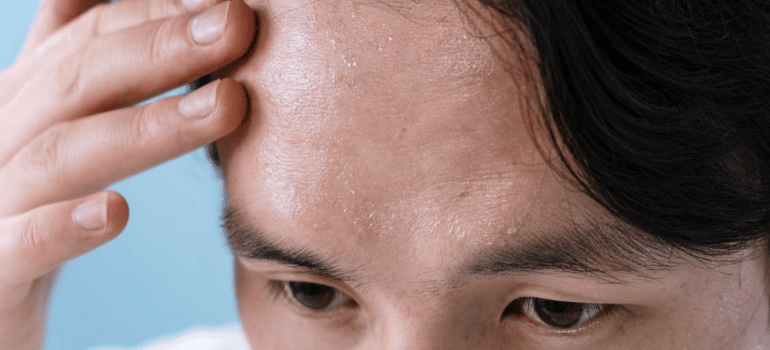
Facts About Opioid and Heroin Drug Use
Heroin use no longer dominates exclusively in urban areas. Several suburban and rural areas communities near Chicago and St. Louis have reported increasing amounts of heroin seized by officials as well as increasing overdose deaths.
The Centers for Disease Control and Prevention (CDC) estimates that the “economic burden” of prescription opioid misuse alone is $78.5 billion a year. This includes the costs of healthcare, lost productivity, addiction treatment, and the involvement of the criminal justice system.
Post-Acute Withdrawal Syndrome (PAWS)
Lastly, as AC also noted above, detox always carries the risk of Post-Acute Withdrawal Syndrome (PAWS). This is typically due to neurological changes caused by heroin use, which heroin rehab centers are equipped to handle.
The symptoms of PAWS are equally powerful and arguably just as dangerous. The University of California, Los Angeles (UCLA) identifies the following PAWS symptoms:
- Difficulty with cognitive tasks, such as learning, problem-solving, or memory recall
- Irritability
- Feelings of anxiety or panic
- Depressed mood
- Obsessive-compulsive behaviors
- Difficulty maintaining social relationships
- Craving originally abused substances
- Apathy or pessimism
- Disturbances in sleep patterns
- Increased sensitivity to stress
Worse still, these symptoms are far less controllable or predictable. AC finds that they “may continue inconsistently for months”, and UCLA that they “might flare up even without any clear stimulus”.
For all of these reasons, we strongly recommend that you only attempt to detox at a medical detox center. Medication, medical assistance, supervision, and psychological and psychiatric support will all help guarantee your safety throughout the process.

Signs of Addiction
In the late 1990s, drug companies assured the medical community that opioid pain relievers would not be addictive to patients. Healthcare providers began to prescribe them at increasing rates. This led to widespread misuse and diversion of these medications before it became clear that they were highly addictive.
Opioid overdose rates began to rise:
- 808,000 people reported past-year heroin use in 2018.
- Poison control centers report that 5,300 children were accidentally exposed to heroin and fentanyl in 2018.
- In 2018, the rate of heroin-involved opioid deaths was 7 times higher than it was 9 years before.
As a result, heroin addicts are at risk for infectious diseases. Substance abuse treatment aims to be the bedrock for heroin addiction.
Help for Heroin Addiction: Signs Of Addiction
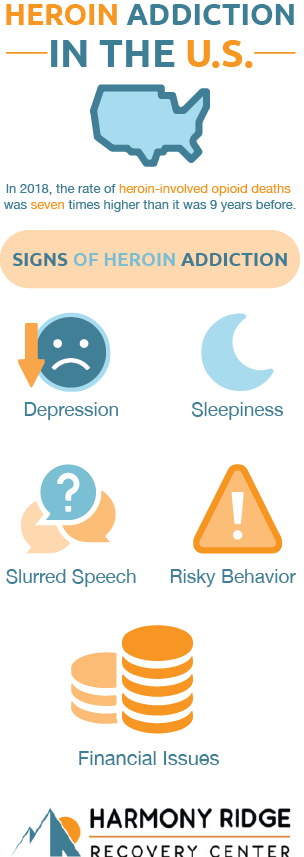
The sooner you can do so and urge them to seek help, the better the chances of success become. For this step, you may look out for signs of addiction – both physical and behavioral.
Indicators Of Heroin Abuse:
- Sleepiness
- Slurred speech
- Depression
- Difficulty remembering things
- Marks from needles (if injecting)
- Runny nose or nose sores (if snorting)
- Constipation
- Obviously lacking self-care
- Secrecy or aggressive behavior
- Money issues
- School or work problems
- Dangerous or risky behavior
WebMD outlines the following physical symptoms:
- Dilated pupils
- Dark circles or puffiness around eyes
- Heavy eyelids
- Droopy facial expressions
- Hacking cough
- Burn marks on mouth or fingers
- Nose bleeds or runny nose
- Track marks on arms
- Scabs from skin picking
- Flu symptoms like fever, aches, nausea
- Weight loss
In addition, you may notice behavioral symptoms like:
- Seeming tired, withdrawn
- Self-isolation
- Appetite changes
- Looking disheveled or having low hygiene
- Increased debts
- Avoiding life obligations and responsibilities
- Having drug paraphernalia, like needles, aluminum foil, and baggies
Anyone who uses heroin or other opioids is taking a chance of developing an opioid use disorder. But some factors increase the risk. A heroin addiction treatment program can give people a fighting chance to learn better coping skills so that they don’t need to rely on using substances such as heroin to cope.
According To The Mayo Clinic, Some Of The Risk Factors In Developing an Opioid Abuse Issue Are:
- Personal or family history of substance addictions
- Heavy use of tobacco
- History of severe depression or anxiety
- Unemployment
- Contact with high-risk surroundings and people
- History of risky behavior
If a person displays one or many of the above risk factors, it doesn’t automatically mean that he or she suffers from a substance use disorder. Various genetic, environmental, and psychological factors often must work together for a person to develop a substance addiction. Anyone that does develop an addiction to heroin though, should receive heroin addiction treatment at a heroin rehab center.
Exact symptoms will of course vary, especially as heroin consumption methods can vary. Still, some early signs like weight loss and tiredness are near-universal.
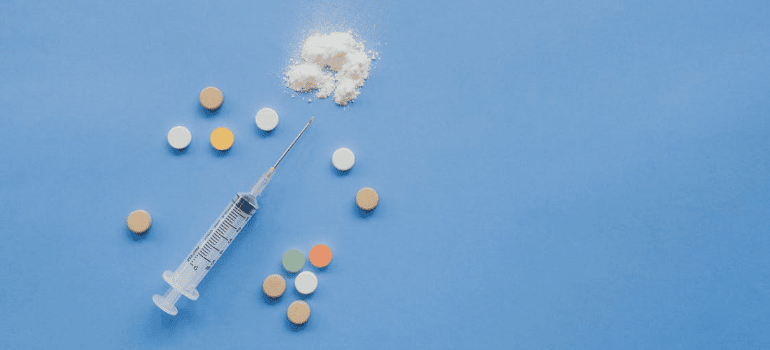
What Is Heroin?
As mentioned earlier, heroin is an illegal opioid. The appearance and texture of heroin range from white powder to brown powder, to black tar. Heroin can be snorted, smoked, or injected.
Originally made from morphine in 1874, heroin was created by a chemist at The Bayer Company of Germany in 1895 and introduced for medical use in 1898. The chemist was attempting to create a less addictive substitute for morphine and gave the new drug the name heroin for its supposed heroic qualities.
Unfortunately, the chemist later discovered that heroin is, in fact, two to three times more potent than morphine and absorbs rapidly into the brain, making it extremely easy for one to develop withdrawal symptoms, and ultimately, a heroin addiction.
How Easy Is It To Develop An Addiction To Heroin?
Individuals that suffer from heroin addiction describe the high that the substance gives them as a feeling of being “covered in a warm blanket, where worries are gone.” (Bhandari, 2018). Because of how pleasant the initial high sensation that heroin use causes one to feel along with how potent heroin is, it is very easy to develop a heroin addiction.
Heroin can be smoked, snorted, or injected directly into the user’s veins. Injecting heroin is the most popular way to take the drug since it’s the quickest way to feel the drug’s high.
Sadly, injecting heroin is the most dangerous way to use the substance as well. This is because the risk for overdose is greater as well as the risk of developing an infection from using dirty needles. Treatment at a heroin rehab center would help a person stop abusing the substance. This, in turn, would also help a person avoid developing infections due to heroin use by injections.
It doesn’t matter how heroin gets into your body; it gets to your brain quickly. After using it only one or two times, it may be difficult to keep yourself from using it again. Thus, soon after many people start using heroin, they start to experience heroin withdrawal symptoms whenever they are not using the substance, or just minimizing their use of the substance. In fact, heroin withdrawal symptoms are notorious.
Most users of heroin are aware of the deadly risks that they take when using the drug yet are unable to discontinue using it. Why? Heroin addiction is extremely powerful. Therefore, people usually require professional medical intervention at heroin rehab centers to overcome it and learn how to manage it.
How Does Heroin Work In The Brain?
Heroin binds to receptors in the brain to release the chemical called dopamine. Dopamine is then used by your nervous system to send messages between nerve cells. This plays a part in how we experience pleasure and pain. It may cause you to think and move slowly as the whole world seems to slow down around you, as the opioid receptors are sensitive.
Experts in the field of drug use and addiction treatment attribute the increase in heroin use with the rising street costs of prescription painkillers such as OxyContin and Vicodin, which are also opioids. People in the market for a stronger, less expensive opioid receive both of these attributes.
Drug dealers have also been lacing heroin with a much more dangerous and potent substance called fentanyl. Fifty to one hundred times stronger than morphine, fentanyl is a synthetic opioid that is being found in more and more supplies of heroin. Heroin withdrawal symptoms are already horrible enough, so one can only imagine how insufferable heroin withdrawal symptoms are when one has been using heroin laced with fentanyl.
Heroin addiction treatment educates patients about the health functions behind drug abuse. Your local addiction treatment center can host events to highlight the benefits of receiving heroin addiction treatment.
The Difference Between Heroin Tolerance & Dependence
All that said, it is just as necessary to distinguish between substance tolerance and dependence. Then, we may distinguish them both from addiction, as research continues to suggest.
Tolerance is a phenomenon that occurs after continued substance use. As the body adjusts to the substance intake it develops a tolerance to it, diminishing its effects. In some cases, this can indeed be dangerous. In seeking the desired effect, substance-tolerant individuals may take higher doses, thus risking a potential overdose. Still, tolerance can occur naturally for many substances, such as caffeine. It does not equal dependence, let alone addiction, but can be a warning sign.
In contrast, dependence is a state where the body cannot properly function without a substance. It has grown dependent on it, and abstaining from it can cause withdrawal symptoms. In the everyday example of caffeine, caffeine dependence can result in symptoms like headaches. This state is a clearer warning sign of addiction, and often requires professional assistance.
Finally, addiction crosses the threshold and makes the individual addicted to the substance. WebMD identifies addiction symptoms like the following:
- Taking a substance without immediately needing it
- Thinking about the substance often
- Hiding the fact you’re using the substance
- Losing interest in activities you used to enjoy
- Engaging in criminal behavior to get it
In brief, tolerance and dependence are both strong warning signs. If you’re under medical supervision and are managing them, you may very well be fine. If you have crossed over into addiction, however, you should seek help as quickly as possible to prevent further complications.

How to Get Started?
If you do choose Harmony Ridge Treatment as your guide on the journey to rehabilitation, getting started is as easy as it is discreet.
To get in contact with our admissions agents, you can either contact us directly at (855) 942-3797 or fill out our admission form. Once we come in contact, we will:
- Explore the basics of your addiction. Doing so will allow us to recommend the programs best suited to your needs, as well as provide any information you may need beforehand.
- Provide financial guidance. As we will also cover later, we accept most major insurance providers – and we want to be as clear and thorough about final costs as possible.
- Answer your questions. You may wonder which items you’re allowed to bring with you, how long the programs last, and so on. Our representatives will answer such questions thoroughly to offer you peace of mind.
Once everything is in order, we will process your application and make all necessary arrangements for your travel and relocation to our facilities. Our West Virginia heroin rehab center will welcome you, and allow you to begin your journey to a new life.

What Is The Treatment For Heroin Abuse?
There is no single perfect cure for heroin addiction or addiction to any other drug. There are various different aspects to a heroin addiction treatment program. The level of care that you’ll receive during heroin addiction treatment will be based on the severity of your addiction.
If your heroin withdrawal symptoms become too much to bear, you may need to take prescription withdrawal medication during detox and even addiction treatment. An effective heroin rehab center can help an individual recover from heroin abuse regardless of the severity of the addiction and withdrawal symptoms.
The type of addiction treatment program a person will need to attend while in rehab depends on various factors, such as the following:
- The person
- The addictive substance
- Co-occurring medical conditions
- Length of addiction
- If the individual has attended a treatment facility in the past
Both behavioral (therapy) and pharmacological (medication) techniques help build some amount of normalcy to behavior and brain function. Research shows that combining both types of addiction treatments is the most effective treatment method if under the supervision of medical professionals.
Family Therapy
Family therapy sessions are also effective within substance addiction treatment programs. Addiction therapy can mold to fit the needs of an individual’s mental illness and heroin addiction.
Opioid drugs possess a stronghold on the spirit of recovering heroin addicts. The fire to relieve withdrawal symptoms presents a slippery slope that will need support from family and friends to overcome. Check to see if your heroin rehab center offers family therapy.
Residential Treatment (or inpatient treatment)
Residential treatment is built for long-term recovery. Medical detox is a common component of heroin inpatient addiction treatment. A heroin rehab center will supply an evaluation depending on the severity of your heroin addiction and mental disorders. Addiction treatment programs are modeled to treat the various stages of addiction.
Outpatient Rehab (or outpatient treatment)
Outpatient rehab is one of the most common, flexible forms of addiction treatment. It would be suited for those who can’t commit to inpatient treatment. If your heroin cravings have been managed to the point where your opioid dependence is mild, you are also a good candidate for outpatient rehab for heroin addiction. Heroin addiction rehab can be discreet yet structured through intensive outpatient treatment.
Dual Diagnosis Treatment
Dual diagnosis treatment simultaneously treats the mental health disorder and substance use disorder that an individual is suffering from. Another term for dual diagnosis disorder is co-occurring disorder.
Individuals with chronic pain are susceptible to co-occurring disorders. Chronic pain and mental health conditions often lead to drug addiction. Many heroin treatment centers offer dual diagnosis treatment.
Heroin Detox Program
Withdrawal symptoms for people who first quit using heroin may be quite severe. Heroin addiction rehab can settle the fever within though. During detoxification, medications are used to ease substance cravings and any painful withdrawal symptoms that frequently cause people to relapse. Medically supervised detox is recognized as the first phase of addiction treatment.
Medication-assisted treatment works to provide medical assistance to patients that are detoxing and recovering from withdrawal from substances such as heroin. Be transparent about your medical history before receiving medication-assisted treatment. Medication-assisted treatment is commonly offered at addiction treatment centers.
Choosing Between Inpatient and Outpatient Program?
Here it is crucial to stress that each addiction differs drastically from the next. Addiction severity varies quite significantly, and how you progress through rehabilitation is also a key factor. In addition, you may also have such factors as outside duties to see too, which may require that you live at home. For these reasons we do not recommend a program outright; instead, we personalize each treatment by opting for the programs which best serve your needs.
The two programs patients are most familiar with are inpatient and outpatient, so here we may begin by comparing the two.
Our West Virginia Heroin Rehab Center’s Inpatient Program
In brief, our residential rehab program is the equivalent of an inpatient program that our heroin rehab centers offer. It is typically ideal for more severe cases, and its key offerings and characteristics are:
- More intensity. Our residential program offers the most intensive care among our programs. It entails 24/7 medical supervision in a clinical setting, and requires more hours of therapy.
- Designated residence. To achieve this high level of care, our residential program requires that patients live in designated facilities. This does allow for swifter support and access to therapists and counselors.
- More focus on medication management. Leveraging its setting, our residential program focuses more on the medication needs of patients. This makes it better suited for such cases as severe dual diagnoses, where psychiatric support is required.
Understandably, our residential program typically works best immediately after medication-assisted treatment. It can serve as the link between detox and IOP programs if needed, or as a standalone step on the journey to recovery.
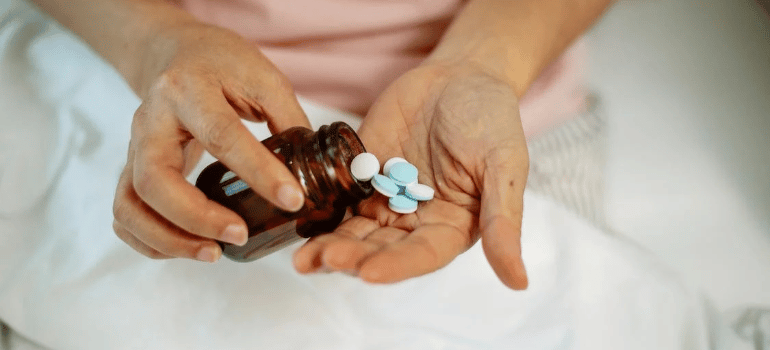
Our West Virginia Heroin Rehab Center’s Intensive Outpatient Program
In contrast, our Intensive Outpatient Program (IOP) comes with a different focus. It best suits milder cases and offers more flexibility, while still being more intensive than general outpatient programs. In comparison to our residential program its characteristics are:
- Less intensity. Our IOP entails approximately 9 hours of service per week, in three 3-hour sessions. It does include pharmacotherapy and medication management where needed, but is overall less intensive than residential programs.
- Freedom of residence. Because our IOP best caters to less severe cases, patients are allowed to live at home during therapy. This flexibility allows them to continue their other duties uninterrupted, such as work or caring for children and the elderly.
- More focus on therapy. Finally, our IOP leans more heavily on individual and group therapy. IOP patients are typically better suited for this focus, as they begin to develop relapse prevention tools and socialize more.

Heroin Withdrawal Symptoms Include:
- Inability to think straight
- Diarrhea
- Stomach pain and throwing up
- Anxiety
- Extreme aches and pains in muscles and joints
- Difficulty sleeping
The amount of heroin that you regularly abuse plays a role in your development of heroin withdrawal symptoms. Lofexidine, which has been used to treat blood pressure, is now approved for use to help with the symptoms of opioid withdrawal during heroin detox and rehab.
How Long Does It Take To Get Off Heroin?
Heroin withdrawal symptoms can last up to a week or more depending on the frequency, amount, and potency of the heroin that was used. Heroin withdrawal symptoms can begin as soon as between 6-12 hours since one’s last use of the substance. The peak of heroin withdrawals lasts between 1-3 days. Post-acute withdrawal symptoms may occur.
Can Heroin Withdrawal Symptoms Kill You?
Heroin withdrawal symptoms can be incredibly uncomfortable but they are not life-threatening. It’s important to avoid quitting your heroin addiction cold turkey though to safely overcome heroin withdrawal symptoms. A heroin rehab center could provide a safe environment for change.
Pharmacological Treatment For Heroin Use
The medications used to treat opioid addiction affect the same brain receptors as the drug but are safer and not likely to cause the same negative behaviors that are typically associated with substance use disorders. These medications utilize either a partial opiate agonist, partial opioid agonist, or the same opioid receptors. Medications used to treat opioid withdrawal symptoms are chosen based on the patient’s specific needs and other factors.
There are three types of medications used in heroin addiction treatment:
- Agonists are considered typical opioids as they activate the pleasure centers in the brain. Methadone is a slow-acting opioid agonist. It is only available through outpatient treatment programs and is dispensed daily.
- Partial agonists activate the opioid receptors but produce a limited response. Buprenorphine is a partial agonist that relieves drug cravings without the side effects of an opioid agonist.
- Antagonists block the receptor and prevent the reward effect of opioids. Naltrexone is an opioid antagonist.
Behavioral Therapy For Heroin Use Treatment
There are many effective behavioral therapy techniques that can help treat opioid use disorders. The heroin addiction treatment process is evidence-based, which is a staple for substance abuse treatment.
The heroin addiction treatment process is useful in both outpatient and residential programs. Behavioral therapy offers a window into the mental health of patients, sometimes a first for them. This highlights the importance of a treatment program.
The National Institute on Drug Abuse recognizes the role behavioral therapy plays within a heroin addiction treatment program. A local mental health services administration should be a resource. Counselors can point you in the direction of a heroin rehab center.
Commonly Used Behavioral Therapies in Heroin Addiction Treatment Are:
Individual and Group Therapy
These types of therapies help an individual understand what was causing his or her addiction in the first place. Individual therapy is intimate and discreet. It better suits people who feel less confident sharing their substance abuse experiences among others.
Individual therapy is a working gateway to discover the underlying causes of addiction. In group therapy, people can discuss their substance abuse and recovery experiences with other people going through similar situations. Ultimately this builds a support group that helps addiction treatment patients grow. Group therapy can be a welcome surprise.
Contingency Management
Contingency management uses a point system where patients earn points for clean drug tests. Points can be used to purchase things that encourage healthy living, such as nutritional meals, memberships to gyms, etc. These amenities may vary at a heroin rehab center.
Cognitive Behavioral Therapy (CBT)—CBT is designed to adjust the patient’s behavior and expectations as they relate to drug use. It is a short-term therapy that helps patients learn new skills in coping with life’s stressors.
Why Do People Relapse from Heroin?
A common complication of addiction treatment is relapse. Addiction is a complicated condition, and recovery often includes obstacles. Rates of relapse are between 40-60%, which is similar to the relapse rates with other chronic diseases such as asthma, hypertension, and Type 1 diabetes.
A heroin addiction treatment program can bring a considerable amount of healing but recovery is a marathon. There are many reasons why people relapse, but the main one is that people have the belief that their addictions are under control and thus, want to test themselves. Other reasons for relapsing include:
- “One last time can’t hurt.”
- Inability to cope with stress
- Difficulty managing physical and emotional pain
- Switching one drug for another
- Unable to address triggers
Further Heroin Relapse Info.
People who relapse are more susceptible to overdose. This is because a dose of heroin you used before relapsing may now be fatal. A single relapse is enough for a person to refuse addiction treatment at a heroin rehab center.
Acute withdrawal symptoms can be an early indication of heroin addiction. Pre-existing mental health issues can be a risk factor for relapse. Mental health issues should be handled with care and support, and the assistance of mental health services administrations.
A sober life requires a support system outside of a treatment program. Treatment providers usually offer a relapse prevention plan that can help prevent heroin relapse. Despite the challenges, there are ways to change patterns to prevent heroin relapse. A relapse prevention plan can provide scenarios for you to rewrite the urge to abuse heroin and other opioid drugs.
Support groups for heroin addiction can be an insightful backbone for a sober life. Support groups for heroin addiction allow people to connect their journey of heroin addiction to others. Heroin addiction treatment centers typically offer support groups for regular heroin addiction meetings.
Heroin Overdose
An overdose occurs when a person uses enough heroin to cause a life-threatening reaction or death. A treatment program might be the key after a heroin overdose.
Heroin overdoses have risen in recent years, doubling between 2010 and 2012. Data from 2018 shows that every day, 128 people in the United States die after overdosing on opioids.
According to the National Institute on Drug Abuse, FDA-approved Naxolone devices deliver higher blood levels of Naxolone than the improvised nasal devices. The National Institute also suggests that families with loved ones with opioid addiction should have Naxolone nearby.
When a person overdoses, their breathing slows or stops, decreasing the oxygen to the brain. If the victim doesn’t die, this can have short- and long-term mental effects on the nervous system, including permanent brain damage.
24-hour Medical Supervision and Care
Between these two programs, you can get the levels of care that best suit you. Whether you need freedom of residence or can dedicate yourself to recovery will also be a factor. However, the primary differentiator between the two lies in the setting; our residential program offers 24-hour medical supervision and care, whereas our IOP does not.
This factor is crucial for a few different reasons, which primarily boil down to the severity of your addiction. Our residential program may thus be a better fit for you if you need:
- Strict medical supervision, if you’re struggling to detox or are grappling with withdrawal symptoms
- Psychiatric care, particularly in cases of co-occurring mental health disorders in dual diagnosis
- Pharmacotherapy and medication management, in cases of other conditions which require medication
Other factors may also necessitate closer medical supervision, including ones of age, gender, and former occupation. Rehab for pregnant women and rehab for veterans, for example, often require more diligence and a more specialized approach. In all such cases, unless the case is otherwise distinctly milder, we recommend residential programs.
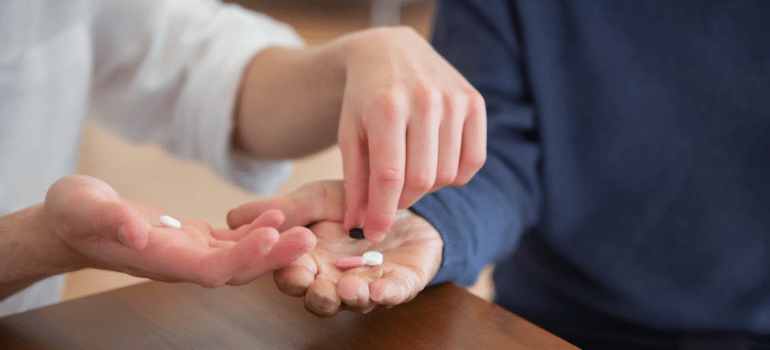
Aftercare
Aftercare treatment refers to the final step of recovery, where the individual is entirely free to do as they wish. In this phase, you will have already developed trigger management and relapse prevention tools through prior programs and will now have the opportunity to put them into practice. To do so, aftercare will offer any of the following, depending on your case and needs:
- Participation in alumni programs
- Connecting with a sponsor
- Attending 12 step-based programs
- Receiving additional therapy
Naturally, aftercare is instrumental in relapse prevention. For this reason, our aftercare program offers open communication channels with your therapists and other specialists, offering a robust support network for whenever you may need it.

12 Step Programs
Having mentioned them above, here we should also clarify 12-step programs. These are not a feature exclusive to aftercare, but are a key offering of all of our West Virginia heroin rehab programs. They are also not exclusive to alcohol rehab, despite their origins.
12-step programs originate from Alcoholics Anonymous (AA). Evoking spirituality and addressing the process of recovery from alcohol addiction, AA provided the foundation for highly structured therapy centered on these steps. Today, the 12 Steps have inspired the 12-step model, which many programs specific to drugs and other substances rely on. They use it to create robust and focused therapy sessions with demonstrable effectiveness.
AAC outlines the principles and benefits of the model as follows:
- The ability to recognize and admit that one is experiencing an addiction problem
- A surrender to the fact that the addiction exists and a decision to seek control through an outer guide
- Self-observation and awareness of the behaviors that were part of and arose from the addiction, as well as those that help promote self-restraint
- A chance to practice that restraint and build self-esteem in one’s positive capabilities
- Achievement of self-acceptance and the ability to change behaviors
- Compassion, both for those who have been affected by the addiction and for others who similarly struggle with addiction
- Tools that make the process a continual practice throughout the individual’s life
Of course, each program will differ from the next. Still, all such programs follow this framework and yield remarkable results, as NIH finds.

Who Helps During the Rehab Process?
Of course, designing, personalizing, and overseeing these programs requires ample experience in the field of addiction treatment. At Harmony Ridge Recovery, we are keenly aware of the responsibility we carry as addiction treatment providers. We approach treatment with utmost professionalism and unwavering diligence, as our team consists of licensed, seasoned experts in their fields.
Our staff includes clinicians and therapists, case managers, alumni coordinators, and more. All of them are fully certified and experienced in their respective positions, and many have seen addiction in their close circles. It is because of them that we are confident in the quality of our services, and that we pride ourselves as the best West Virginia heroin rehab center.
How to Help a Loved One With a Heroin Addiction?
Having discussed all of the above, you may be seeking rehab for a loved one instead of yourself. In this case, let us outline how you may best support them, as we feel all heroin rehab centers should do.
Scheduling an Intervention
If you’re past the early stages and are certain of an addiction, you should then intervene as quickly as possible. Being swift and decisive does not mean being abrupt or forceful, however; aggression may have very adverse outcomes.
Instead, you should be thoughtful and supportive. In line with MedlinePlus’s recommendations, we strongly suggest that you:
- Be calm. It’s not easy to address such issues calmly, but you must remain controlled and supportive. Do not confront them directly, lecture them, or accuse them; doing so may drive them away.
- Don’t label them. Labels like “addict” or “sick”, often have adverse effects too. Focus on the problem rather than the individual.
- Help them in person. Offer to make arrangements for them and accompany them to therapists and medical professionals yourself. Staying by their side will help them immensely.
- Don’t give up. It is not easy for an addicted individual to accept their condition or agree to seek help. Offer as much support as you can in a healthy way.
Naturally, each individual will respond differently to interventions. If you’re finding it hard to support your loved one, please contact us; we will do our best to suggest the best course of action for you.

Outlook For The Future
In 2019, The National Institute on Drug Abuse reported that nearly 50,000 people in the United States died from opioid-related overdoses. Although heroin addiction is a serious condition, it doesn’t have to be permanent or even long-term, especially through a treatment program. It is a treatable disease. If you are seeking help for yourself or someone close to you, act now. It is not necessary or recommended to wait to “hit rock bottom.”
The recovery process is not linear but possible. Drug abuse does not have to be a seal for your fate. There is scientific evidence that combining medical and therapy-based treatments can give you the opportunity to recover at a treatment program and lead a healthy life.
Drug abuse can be managed through your patience. Heroin addiction treatment works as a valuable resource. New federal rules have been enacted governing confidentiality and disclosure of substance abuse patient records.
Harmony Ridge Recovery Center is located in the Mid-Ohio Valley in Walker, West Virginia.
Surrounded by 50 acres of lakes and forest land, it is the perfect place to begin a journey of any type. Our comprehensive treatment programs will set you up to succeed on your journey to recovery.
If you are ready to change your life, contact us today. We have a 24-hour helpline waiting to hear from you.
Reasons to Choose Harmony Ridge - One of the Best West Virginia Heroin Rehab Centers
Finally, here we can consolidate what sets us apart from our heroin addiction treatment peers. In brief, our unique benefits are the following three.
#1 Individualized Treatment for Each Client
As we’ve outlined above, we do not make broad and careless program recommendations. All of our programs follow robust industry standards, and all have been tried and tested manifold. However, we deeply understand that each case of addiction differs from the next.
To address this, we pride ourselves on flexible, progressive, and individualized treatment for each and every client. With a keen focus on case management, we recommend the programs and therapies that best cater to each patient’s needs. As they progress through their journey to recovery, we adjust our methods, treatments, and recommendations accordingly. Heroin addiction treatment does not have a one-size-fits-all formula, and we at Harmony Ridge understand this well.
#2 Peaceful Setting & Pleasant Facility
We offer a uniquely peaceful setting and pristine, state-of-the-art facilities. Surrounded by the idyllic West Virginia countryside, our locations are serene and help our patients attain peace of mind. This proximity to nature offers ample psychological benefits, as PsychologyToday finds, which demonstrably help rehabilitation from all addictions.
In addition, our clinical and residential facilities are fully equipped to meet every case’s needs. They both offer a safe and welcoming environment, removed from harmful potential triggers and disrupting distractions. If you’d like to see them for yourself, you may visit our photo gallery or take a video tour of our facilities.

#3 Sober Activities That Boost Your Creativity & Help Your Recovery
All of our programs offer ample therapeutic activities to further help the individual grow and thrive, expressing themselves and moving away from addiction. These activities do differ depending on the program, but they all follow the principle of holistic therapy which we strive to uphold.
These therapeutic activities include:
- Art therapy
- Adventure therapy
- Biofeedback
- Music therapy
- Outdoor therapy
- Yoga
- Guided meditation
- Reiki and tai chi
- Spiritual therapy
Heroin Rehab Costs and Payment Plans
Having covered the subject of heroin addiction itself, here we may also reassure you of our treatment costs. We understand that heroin rehab centers may seem prohibiting cost-wise, especially in such trying post-COVID times. Still, you can rest assured we accept all major insurance providers, including:
However, there may be cases where your plan or provider does not cover the full expense of your treatment plan. This may be due to prior addiction history, treatment duration and needs, and other factors unique to your state or plan. For such cases, our representatives will also explore other payment options with you, including self-pay, personal loans, and Medicaid. If you need such assistance, or any other information, feel free to give us a call at (855) 942-3797. Our representatives are available 24/7, and will always be more than happy to answer your questions.

Contact Us Today!
Whether it’s for yourself or a loved one, heroin addiction is a very challenging ordeal. It can inhibit personal life and growth, harm relationships, and present very real risks to the person’s physical health and wellbeing. It is not easy to come to terms with, and the first step of seeking help is always the hardest.
We at Harmony Ridge Recovery understand these hardships very well, and feel fully confident in our ability to help you. Our West Virginia heroin rehab center comes fully equipped to meet your needs, in a safe and welcoming environment. If you’re ready to seek help, we’re here to accompany you on a journey to recovery like no other. Contact us today, and let us reclaim the life you deserve.
FAQ
Why is heroin so addictive?
Heroin is indeed highly addictive, much more so than many other substances. There are a few different reasons for this, alongside other factors which affect final addiction rates and fatal overdose rates.
A primary reason lies in its very powerful effects once consumed. The individual feels very intense euphoria and wakefulness, which make it highly desirable. Exact effects will of course vary, but heroin is generally very alluring.
A second reason lies in how it affects the brain. As a powerful depressant, it effectively rewires the brain and kindles dependency. Cravings soon become too powerful to ignore, and withdrawal symptoms are often too severe for the individual to attempt to quit.
Finally, heroin is consumed in different ways and in combination with other substances – often fentanyl. This broadens its appeal as well, driving more people to addiction and gripping them shortly after. Unfortunately, combinations with other substances also increase heroin’s already notable fatal overdose rates.
Can I detox from heroin without medical assistance?
In most cases, no. This question often stems from one of two intents; to either detox without any professional help, or to detox under professional care but without medication.
Attempting to detox from heroin on your own is both very unlikely to succeed and highly likely to put you at risk. We strongly suggest that you do not try to do so, and kindly urge you to seek medical and professional assistance.
Heroin grips the brain – so withdrawal symptoms are typically too severe to overcome naturally. Even after initial detox, the obstacle of PAWS will emerge shortly as well. Those two factors in combination make natural detox very unlikely to succeed, even under medical supervision.
That said, there is no need to fear medication-assisted treatment (MAT). The medications used are approved by the FDA, and have been proven to not kindle addictions of their own. We understand the aversion to them at that stage, but MAT medications are demonstrably safe and effective.
Which program works best for heroin addiction?
It strictly depends on the individual case and its surrounding factors. Put differently, there is no one program which always works best for heroin addiction specifically. Rather, it depends on the severity of each addition, co-occurring mental health disorders, and similar factors unique to each case.
Typically, milder cases will require MAT, followed by either an inpatient program or a IOP (intensive outpatient program). If substantial progress is made, a brief IOP might suffice before advancing to aftercare. In contrast, more severe cases will typically require longer inpatient treatment and more thorough IOPs. They will also often require more extensive aftercare, including 12-step programs.
All in all, every program works best in sequence toward the common goal of rehabilitation. There is no one program which works best in isolation, and program appropriateness should be decided on a case-by-case basis.
How long does heroin treatment last?
Total heroin treatment will vary quite significantly. As noted above, heroin addictions are often harder to tackle, and each individual case will differ from the next in many ways. Each individual will make different progress, and may encounter different challenges along the way. As such, it is very hard to provide an exact expected duration.
Still, detox typically lasts for one to two weeks. Inpatient treatment may last anywhere from a month to three, but there isn’t a set duration which works for everyone. IOPs typically last from one month to four, and such aftercare should typically last for at least three months but can extend to eighteen months or more.
In brief, how long heroin treatment lasts will always depend on the exact programs one needs. A year may sometimes be an accurate enough estimate, but it truly depends on each case’s characteristics and the individual’s progress.
Does heroin treatment prevent relapse?
Unfortunately, no. Relapse is very common for many addictions, and heroin addiction is no exception. If anything, its powerful effects on the brain might make a relapse more likely than some other substances.
Still, while relapse may not yet be fully avoidable, long and thorough programs significantly lower relapse rates. Studies have found a strong correlation between robust aftercare programs, following evidence-based treatment, and lower likelihood of relapse.
Therefore, while treatment cannot rule out a relapse, thorough treatment and strong support networks can help prevent it. If you do choose Harmony Ridge Recovery for heroin treatment, our unyielding professionalism and extensive aftercare will strive to minimize the risk of relapse as much as possible.
Jump To Section
Begin Your Journey to Healing Here
Ask me about recovery, I can help you!
Our recovery specialists are standing by 24/7 to help you or your loved one.
Or call us: 


